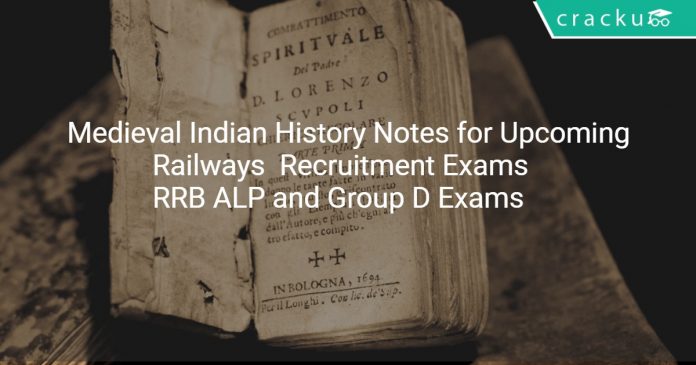Medieval Indian History PDF Notes for Competitive exams:
This is an medieval Indian history notes for UPSC, SSC CGL, SSC CHSL, Railways RRB ALP, RRB Group-D, NTPC, JE exams.
Medieval Indian history PDF Notes for Competitive exams
20 RRB NTPC Mocks for Rs. 149 – Enroll here
Download Ancient Indian History Notes PDF
Download Modern Indian History Notes PDF
Important One-Liners from Medieval Indian History :
- Medieval Period of the Indian History is the period from the beginning of the Eight Century to the end of Eighteenth Century.
- The time period between the end of Gupta Period and the early Invasions in Medieval Period saw many smaller kingdoms struggling for Prominence especially in North India. However, many Kingdoms didn’t retain superiority for long.
- Notable kingdoms during the early Medieval Period are:
- Rashtrakutas
- Pratiharas
- Palas
- Rajputs in North
- Cholas in South
- Struggle for kannauj or Tripartite Struggle is an notable struggle for control over Kannauj by the three Kingdoms – Rashtrakutas, Pratiharas and Palas.
- Notable King of the Rashtrakutas Dynasty is Amoghavarsha
- Notable King of the Pratiharas Dynasty is Bhoja
- King Bhoja adopted a title “Adivaraha”
- Chalukyas rose to power primarily at the Central India after decline of these above mentioned three kingdoms after a span of 100 Years.
- Chalukyas Dynasty was established by Pulakeshin – I
- Badami in Karnataka is the Capital of Chalukya Dynasty
- Another notable King of the Chalukya Dynasty was Vikramaditya – I who defeated Cholas, Pallavas and Pandyas and gained supremacy of the empire in the region.
- Another Important event which took place in early medieval period is the Prophet Mohammed Preached the new Religion of Islam in the 7th Century AD.
- Other Important Kingdoms of the same period are
- Chandelas in the Bundelkhand
- Chahamana Dynasty
- Tomaras
- An Important Powerful King of this period is Prithviraj Chauhan III
- Chola Dynasty ruled major parts of south India for almost 400 Years (9th Century to 13th Century).
- Rajaraja is the notable Powerful ruler of the Chola Dynasty
- The famous Brihadisvara Temple in Thanjavur is built by King Rajaraja
- Sri Lanka was also captured by the Chola King Rajaraja after defeating Anuradhapura Kingdom and later established itself in most part of the Island during the reign of Rajendra Chola Son of Rajaraja.
- Last ruler of the Chola Dynasty is Rajendra III
- Mohammed Ghazni and Mohammed Ghori are the two earlier invaders of early medieval Period.
- Ghazni was a small kingdom in Afghanistan found by the Turkish Noblemen in tenth Century.
- One of the successors the Ghazni Kingdom, Mohammed wanted to make Ghazni famous and wanted to establish the kingdom in part of Central Asia for which he required huge money to maintain a Powerful Army, he learnt that India was a rich country and therefore decided to conquer India for wealth.
- In a span of 25 Years Mohammed made seventeen raids on India. First raid by Muhammad on India was in 1000 AD
- Mohammed has destroyed the Somnath Temple in Western India in search of Gold and Money
- Chauhan Dynasty ruler Prithviraj was defeated by Mohammed Ghori in the second Battle of Tarain
- Shah Namah which is the national epic of Greater Iran is a poem written by a Persian Poet Firdausi
Railways Group D Previous Year Papers
Slave Dynasty :
- The Delhi Sultanate began with the Slave Dynasty who ruled India after the death of Mohammad Ghori
- Slave Dynasty: Qutb-ud-din Aibak is the first king of the slave dynasty, who was also the General of Mohammad Ghori
- Sultanate faced problems from the frequent conquests of Mongol People let by Chneghiz Khan.
- Sultanate was ruled by Raziya Sultana after the death of Illtutmish, who was the third sultan of Delhi after Arom Shah, Son of Qutb Ud din Aibak, was assassinated by him in the battle of Jud.
- Another notable and one of the last rulers of Slave Dynasty is Balban
- The practice of ‘Sijdah’ was implemented by Balban. Sijdah is to kneel and touch the ground with their forehead in salutation to Balban.
Khilji Dynasty (1290-1320):
- Jalal Ud Din Firuz Khilji is the founder of Khilji Dynasty.
- Notable Ruler of the Khilji Dynasty is Allauddin Khilji who was the nephew and son in law of Jalal ud din Khilji
- Allauddin Khilji self-styled himself as the second Alexander and was very ambitious in conquering the world
- Allauddin Khilji has sent his Slave General, Malik Kafur to the Southern peninsula to conquer and obtain gold and money for the Kingdom
- Malik Kafur has conquered Madurai giving him the credit of first north Indian ruler to penetrate so far in the south India.
- Many Khiljis succeeded Allauddin Khilji but no one sustained power for long which led to the rise of a new Dynasty called Tuglaq Dynasty
Tuglaq Dynasty (1320 – 1413)
- Ghazi Malik is the first ruler of the Tuglaq Dynasty
- Notable ruler of the Tuglaq Dynasty was Muhammad Bin Tughlaq
- The famine in Daob Region which was a major source of revenue collection worsened the condition of the dynasty.
- Capital of Delhi is moved to Devagiri – renamed as Daulatabad under the reign of Muhammad bin Tuglaq
- Firoz Shah Tuglaq, successor of Muhammad Bin Tughlaq started the Yamuna Canal and he was the last know powerful ruler of the Tuglaq Dynasty which led the rise of a new Dynasty Sayyid Dynasty
Sayyid Dynasty(1413-1451):
- Khizr Khan is the founder of Sayyid Dynasty ( 1414-1421)
- The last sultan of Sayyid Dynasty was Allauddin Alam Shah who ruled till 1451
- Allauddin Alam Shah was defeated by Bahlul Lodi which led to the rising of Lodi Dynasty
Lodi Dynasty(1451-1526):
- Lodi Dynasty was founded by Bahlul Lodi who ruled the sultanate from 1451-1489
- An Important ruler of this dynasty is Sikandar Lodi who self-styled himself as the Sikandar Shah
- Agra City was founded by Sikandar Lodi in 1504 and moved the capital from Delhi to Agra
- Ibrahim Lodi was the Last ruler of the Lodi Dynasty who was defeated by Babar in 1526 in the first battle of Panipat which led to the rise of Mughal Empire
Late Medieval Period started with the beginning of Mughal Empire
Mughal Empire:
- Babur was the founder of Mughal Empire in 1526.
- Battle of Khanwa was fought between first Mughal Emperor and Rajput Ruler Rana Sanga
- Babur also conquered Forts of Gwalior, Dholpur etc
- Babur was a descendant of two of the most legendary warriors of Asia
– Chenghez Khan and Timur
- Tuzuk-i-Baburi is considered one of the important classics of World Literature is the memoir of Babur.
Humayun (Second Ruler of the Mughal Empire1530 – 1556)
- Humayun is the Son of Babur
- Humayun defeated the Afghans in 1532 who Conquered Bihar and Jaunpur in Uttar Pradesh
- Chunar Fort located in Mirzapur District of Uttar Pradesh is often referred to as the Gateway of the Eastern India during the Mughal Period.
- Dinpanah an ancient city near to Delhi was developed by Humayun during his reign
- Humayun defeated and killed Tatar Khan, a cousin of Ibrahim Lodi, who was supplied Arms by Bahadur Shah to conquer Agra.
- “Gaur” or “Gauda” the capital of Bengal in the Medieval Period was invaded by Humayun
- The Battle of Chausa was fought between Mughal Emperor Humayun and Afghan Ruler Sher Shah Suri in 1539 at Chausa, 10 Kms away from Buxar where Humayun was defeated.
- Sher Shah Suri defeated Humayun at the Battle of Kanauj in 1540 which ended the empire of Humayun.
- Humayun regained the kingdom back in 1555 however he didn’t live long.
- Humayun died after falling from the First Floor of the Library Building in his fort at Delhi
- Tomb of Humayun was built at the Order of Akbar
- Mirak Mirza Ghiyas, a Persian Architect designed the tomb of Humayun
Sur Empire (1540-1555):
- Sur Empire was founded by the Afghan ruler Sher Shah Suri
- The Patron of Sher shah has adorned him the title of “Sher Khan” after Sher Shah killed a Tiger
- Battle of Sammel is fought between Rajputs and the Afghan ruler Sher Shah Suri. Sher Shah conquered Ajmer and Jodhpur
- Islam Shah ruled the Sur empire after the death of his father Sher Shah Suri in 1545
- Abbas Khan Sarwani wrote the “ Tarikh-i-Sher Shahi” – History of Sher Shah
- Sher Shah built “Sarai” for the convenience of the Travelers at a distance of 8 Kms on all major Roads. Sarai is a lodging or an Inn where travelers could pass the night and keep their goods in safe custody.
- The Poem Padmavat was written by Malik Muhammad Jayasi who was an Indian Sufi Poet was a notable patron of the Sher Shah
Get RRB Unlimited at Rs. 249 – Use coupon RRBDREAM70
Akbar Rule(1556-1605):
- Akbar was crowned at Kalanaur at the age of 13 Years in 1556 after the death of his father Humayun
- Khan I Khanan is the title given to the Tutor of Prince Akbar, Bairam Khan, who later became the Advocate of the Kingdom
- Hemu was a Hindu general under Adil Shah Suri was appointed as Wazir and given the title “Vikramjit”. Hemu was considered a threat to Akbar
- Second Battle of Panipat was fought between Mughals (Led by Bairam Khan) and Afghan Forces (Led by Hemu)
- Akbar Introduced a new Land measurement system known as Zabti System
- The process of dividing produce among peasants and state on a proportionate basis – Batai System was introduced by Akbar
- The top most administrative unit in the Akbar’s administration was called Subhah
- Paragana was a collective administrative unit of few Villages
- Sarkar was a collective administrative unit of few Paraganas
- The chief officer of Subhah was called subedar
- Akbar abolished the Jizyah which was used by the nobles sometimes to humiliate Non- Muslims. Jizyah is a tax collected only from Non-Muslim
- Battle of Haldighati was fought between Rana Pratap and Mughals led by Man Singh
- Contemporary popular saints Chaitanya, Kabir and Nanak belonged to this period
- Abul Fazal and his Brother Faizi were notable scholars of the time of Akbar reign
- The most trustworthy nobles of the Akbar court are Mahesh Das and Raja Birbal
- Ibadat Khana or the hall of prayer was built by Akbar in the new capital of Fatehpur Sikri
- Akbar stopped the practice of Sati and Legalized Widow Remarriage
- Battle of Bannihatti was was fought between Vijayanagara Empire and Deccan Sultanates
- Akbar died in 1605 and by 1610 most of the kingdoms won by Akbar were lost
- Shah Jahan ascended to the thrown in 1627
- The architect of Gol Gumbaz was Yakut of Dabul
- Nur Jahan was married to Jahangir in 1611
- Shah Jahan has killed his elder brother Khusrau and spread the news that he died due to abdomen pain
- The Lal Qila or the red fort was built by Shah Jahan
- Agra Fort was built by Akbar
- Buland Dawaza was built in 1576 at Fatehpur Sikri to commemorate Akbar’s victory in Gujarat
- Jaswant and Dasawan were the famous painters of the Akbar’s Court
- Utbi and Naziri were two other leading Persian poets of the Mughal era along with Abul Fazal and Faizai
- Akbar patronized Miyan Tansen, a great musician of the Gwalior
- Fifth Sikh Guru, Guru Arjan Das completed the compilation of Sikh Scriptures.
- Guru Arjan Das was killed by Jahangir
- Dara Shikoh, the eldest son of Shah Jahan got the Gita translated into Persian
- Battle of Samugarh and Battle of Deorai were fought between Dara and the Mughal Emperor Aurangazeb
- The last and the longest ruling Mughal Emperor was Aurangazeb for almost 50 Years
Marathas:
- Marathas was another important kingdom. Shivaji the son of Shahji Bhonsale is credited with defeating the Mughals and considered the Kingmaker of Ahmednagar.
- Treaty of Purandar was signed between Rajput ruler Jai Singh- I who was the commander of the Mughals and Chhatrapathi Shivaji Maharaj
- Shivaji has assumed the title of “Haindava Dharmoddhaarak”
- There were not many notable rulers in the Mughal Empire after Aurangazeb
- The last Emperor of the Mughal Empire was Bahadur Shah II 1837-1857






[…] Download Medieval Indian History Notes PDF […]
[…] Medieval Indian History PDF Notes […]
[…] Medieval Indian History PDF Notes […]